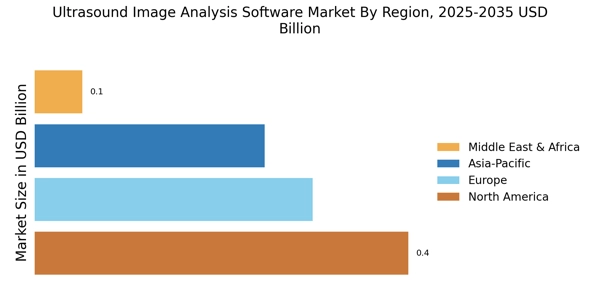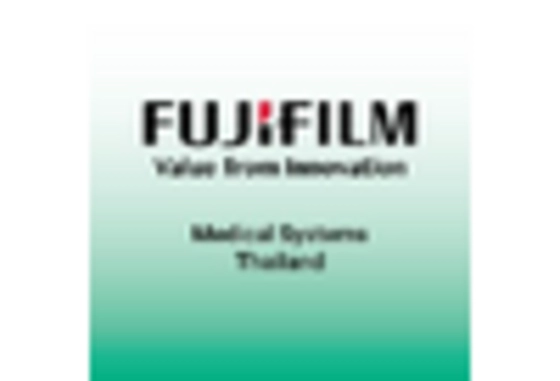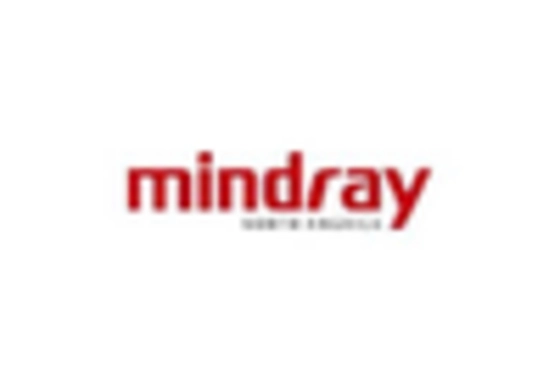Growing Prevalence of Chronic Diseases
The rising prevalence of chronic diseases is a pivotal driver for the Ultrasound Image Analysis Software Market. Conditions such as cardiovascular diseases, diabetes, and cancer necessitate regular monitoring and accurate diagnostics, which ultrasound imaging can provide. The World Health Organization has reported a steady increase in the incidence of these diseases, leading to a heightened demand for effective diagnostic tools. As healthcare providers seek to enhance patient care and improve diagnostic accuracy, the adoption of ultrasound image analysis software is likely to increase. This trend is expected to contribute to a robust market growth trajectory, with projections indicating that the market could reach several billion dollars in value by the end of the decade. Consequently, the need for advanced ultrasound solutions is becoming increasingly critical in managing chronic health conditions.
Growing Emphasis on Preventive Healthcare
The growing emphasis on preventive healthcare is significantly influencing the Ultrasound Image Analysis Software Market. As healthcare providers shift their focus from reactive to proactive care, the demand for diagnostic tools that facilitate early detection of diseases is increasing. Ultrasound imaging plays a vital role in preventive healthcare by enabling routine screenings and assessments. This shift is supported by various health initiatives aimed at promoting early diagnosis and intervention, which are essential for improving patient outcomes. The market is expected to benefit from this trend, with estimates suggesting that the demand for ultrasound image analysis software could rise substantially in the coming years. This focus on preventive measures is likely to drive innovation and investment in ultrasound technologies, further propelling the market forward.
Rising Adoption of Point-of-Care Ultrasound
The Ultrasound Image Analysis Software Market is witnessing a notable shift towards point-of-care ultrasound (POCUS) applications. The convenience and immediacy of POCUS allow healthcare providers to perform ultrasound examinations at the bedside, facilitating quicker decision-making and treatment initiation. This trend is particularly beneficial in emergency and critical care settings, where timely diagnostics can significantly impact patient outcomes. The increasing adoption of portable ultrasound devices, coupled with advanced image analysis software, is driving the market forward. Reports indicate that the POCUS segment is expected to grow at a CAGR of approximately 12% over the next few years. This growth reflects the healthcare sector's ongoing efforts to enhance diagnostic capabilities and improve patient care through innovative ultrasound solutions.
Technological Advancements in Imaging Techniques
The Ultrasound Image Analysis Software Market is experiencing a surge in demand due to rapid technological advancements in imaging techniques. Innovations such as 3D and 4D ultrasound imaging are enhancing diagnostic accuracy and providing more detailed visualizations. These advancements not only improve patient outcomes but also streamline workflow in clinical settings. The integration of sophisticated algorithms and machine learning capabilities into ultrasound software is enabling healthcare professionals to analyze images with greater precision. As a result, the market is projected to grow significantly, with estimates suggesting a compound annual growth rate (CAGR) of over 10% in the coming years. This growth is indicative of the increasing reliance on advanced imaging technologies in various medical applications, thereby driving the Ultrasound Image Analysis Software Market forward.
Increased Investment in Healthcare Infrastructure
Investment in healthcare infrastructure is a crucial driver for the Ultrasound Image Analysis Software Market. Governments and private entities are increasingly allocating funds to enhance healthcare facilities, particularly in emerging economies. This investment is aimed at improving diagnostic capabilities and expanding access to advanced medical technologies, including ultrasound imaging. As healthcare systems evolve, the demand for sophisticated ultrasound image analysis software is likely to rise, driven by the need for efficient and accurate diagnostic tools. Market analysts suggest that this trend could lead to a substantial increase in the market size, with projections indicating a potential doubling of the market value within the next five years. Enhanced healthcare infrastructure will not only facilitate the adoption of ultrasound technologies but also improve overall patient care.


















Leave a Comment